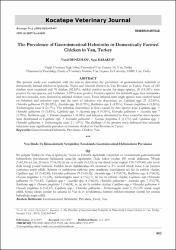The prevalence of gastrointestinal helminths in domestically farmed chicken in Van, Turkey
Künye
Denizhan, V. & Karakuş, A. (2019). The Prevalence of Gastrointestinal Helminths in Domestically Farmed Chicken in Van, Turkey . Kocatepe Veterinary Journal , 12 (4) , 443-447 . DOI: 10.30607/kvj.631622Özet
The present study was conducted with the aim to determine the prevalence of gastrointestinal helminth in
domestically farmed chicken in İpekyolu, Tuşba and Edremit districts in Van Province in Turkey. Feces of 185
chicken were examined and 78 chicken (42.16%) yielded positive results for single species, 26 (14.05%) were
positive for two species, and 6 chicken (3.25%) were positive for three species. Six helminth eggs, four nematodes
and two cestodes, were detected in infected chicken feces. Those infected with single species were studied based
on helminth and infection types and the rates of infection was determined as: Capillaria spp. 23 (12.50%),
Heterakis gallinarum 19 (10.32%), Ascaridia spp. 18 (9.78%), Raillietina spp. 8 (4.35%), Davania proglottina 6 (3.26%),
Trichostrongylus tenuis 4 (2.17%). The infection determined in feces caused by two species were Capillaria spp. +
Heterakis gallinarum 10 (5.43%), Capillaria spp. + Ascaridia spp. 8 (4.35%), Heterakis gallinarum + Ascaridia spp. 7
(3.78%), Raillietina spp. + Davania proglottina 1 (0.54%) and infection determined in feces caused by three species
were determined as Capillaria spp. + Heterakis gallinarum + Davania proglottina 4 (2.17%) and Capillaria spp. +
Heterakis gallinarum + Trichostrongylus tenuis 2 (1.09%). The findings of the present study indicated that helminth
infections were significantly prevalent in domestic chicken in Van Province in Turkey. Bu çalışma Türkiye’de Van ili İpekyolu, Tuşba ve Edremit ilçelerinde yetiştirilen ev tavuklarında gastrointestinal
helmintlerin prevalansını belirlemek amacıyla yapılmıştır. Dışkı bakısı yapılan 185 tavuk dışkısının 78’inde
(%42,16) tek tür, 26’sında (%14,05) iki tür ve 6’sında (%3,25) üç tür olmak üzere toplam 110 (%59,46) adet tavuk
dışkı örneği pozitif bulundu. Enfekte tavuk dışkılarından 4’ü nematod ve 2’si cestod olmak üzere 6 tür helmint
yumurtası tespit edildi. Helmint ve enfeksiyon türlerine göre oranlarına bakıldığında tek tür ile enfekte olanlar;
Capillaria spp. 23 (%12,50), Heterakis gallinarum 19 (%10,32), Ascaridia spp. 18 (%9,78), Raillietina spp. 8 (%4,35),
Davania proglottina 6 (%3,26), Trichostrongylus tenuis 4 (%2,17), iki tür ile enfekte olanlar; Capillaria spp.+Heterakis
gallinarum 10 (%5,43), Capillaria spp.+ Ascaridia spp. 8 (%4,35), Heterakis gallinarum+ Ascaridia spp. 7 (%3,78),
Raillietina spp.+ Davania proglottina 1 (%0,54), ve üç tür ile enfekte olanlar; Capillaria spp.+ Heterakis gallinarum +
Davania proglottina 4 (%2,17), Capillaria spp.+ Heterakis gallinarum+ Trichostrongylus tenuis 2 (%1,09) olarak tespit
edildi. Sonuç olarak yapılan bu çalışma ile Van ili ev tavuklarında helmint enfeksiyonlarının önemli bir oranda
bulunduğu tespit edildi.
Kaynak
Kocatepe Veteriner DergisiCilt
12Sayı
4Bağlantı
https://dergipark.org.tr/tr/pub/kvj/issue/48417/631622https://doi.org/10.30607/kvj.631622
https://hdl.handle.net/11630/9223
Koleksiyonlar
- Cilt 12 : Sayı 4 [16]



















